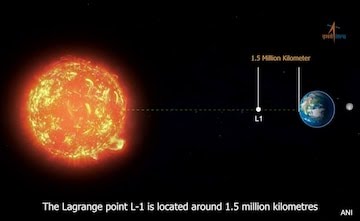Indian Space Research Organisation’s Aditya-L1, India’s first mission to study the sun, is set to reach its final destination orbit on Saturday, over four months after it began its ambitious journey from ISRO’s Sriharikota launchpad. Built at a cost of Rs 400 crore, the nearly 1,500 kg satellite will function as the first space-based Indian observatory to study the sun nearly 1.5 million kilometres from the Earth.
The satellite is expected to be placed in a halo orbit around Lagrange point 1 (L1) at around 4 pm. The final insertion point was chosen for its advantageous position which remains unhindered by eclipses and can be used to view the Sun continuously.
“This manoeuvre (at around 4 pm on Saturday) will bind the Aditya-L1 to a halo orbit around L1. If we don’t do this, there is a possibility that it will continue its journey, maybe towards the Sun,” an ISRO official told.
The space observatory will keep an eye on the changing space weather and warn scientists about unfavourable changes including solar storms and flares that may impact the working of satellites. A solar storm is a large-scale magnetic eruption on the Sun, which can effect the entire solar system.
“Since Aditya-L1 will look at Sun continuously, it can warn us of imminent solar electro-magnetic effects on Earth and protect our satellites, and other power electrical and communications networks from getting disrupted. This will help continue normal operations by operating them in safe modes, till the solar storm passes by,” ISRO Chairman S Somanath had told
Mr Somnath said that India has assets worth over ₹ 50,000 crores in space including over 50 operational satellites that need to be protected against the wrath of the Sun.
The Aditya-L1 satellite, carrying seven payloads, will also conduct scientific experiments to better understand the photosphere, chromosphere and the outermost layers of the Sun (the corona) using electromagnetic, particle and magnetic field detectors.
Apart from the less-studied solar weather, the satellite will gain crucial information about pre-flare and flare activities and the dynamics of space weather.
According to ISRO, these are the major scientific objectives of Aditya-L1 mission:
Study solar upper atmospheric (chromosphere and corona) dynamics
Study chromospheric and coronal heating, the physics of the partially ionized plasma, the initiation of the coronal mass ejections, and flares
Observe the in-situ particle and plasma environment, providing data for the study of particle dynamics from the Sun
Study the physics of solar corona and its heating mechanism
Diagnostics of the coronal and coronal loops plasma: Temperature, velocity and density
Development, dynamics and origin of CME (Coronal Mass Ejections)
Identify the sequence of processes that occur at multiple layers (chromosphere, base and extended corona) which eventually leads to solar eruptive events
Magnetic field topology and magnetic field measurements in the solar corona
The origin, composition and dynamics of solar wind, the drivers for space weather
👉 Click here to read the latest Gujarat news on TheLiveAhmedabad.com




